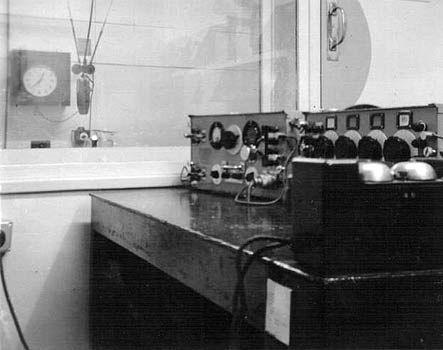
Mixer 3 Cubicle, July 1949
In 1949, after a five-week conversion course at the Langham with Cyril Bumpstead (Drama PE) and Brian Begg (Light Ent.), I was posted to 200 Oxford St with Frank Doran. Other members of our course were Roy Maynard, Alma Charlton, Matt Caruth from Northern Ireland and A. N. Other. Most of the time on the course was spent on sound effects exercises or on "In Town To-night" - all good fun and quite a change from life on high-power transmitters.
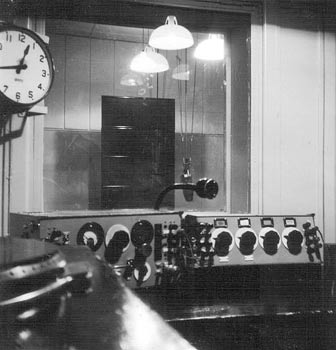
Studio 1 Cubicle
PEs and JPEs operated the panel for all programmes, played all commercial records and sound effects and also 17.5 inch direct recordings. All other direct recordings - 78s - were played by Recorded Programmes Assistants from Recordings Department. On a live programme in a cubicle with two TD/7s this could cause quite a squash!
Studios at 200 were all equipped with an OBA/8 and MX/18 plus TD/7(s) - an STC 4021 was used for talk-back while the AXBT was the standard studio mic. For discussion programmes an STC 4033 was available but had to be collected from the Control Room.
OS 1 & OS 2 were small talks studios and each had a single TD/7. In OS 1 (right) there was a manhole cover in the cubicle floor and the River Fleet ran beneath it - the sound of running water could often be heard in the background.
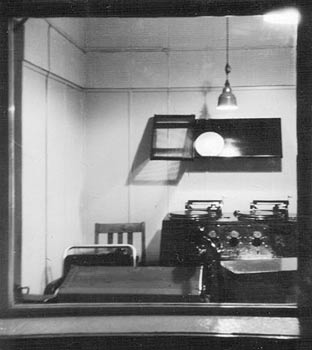
Studio 2 Cubicle
Some of the eminent speakers I recorded in these two studios include Salvador Dali, J B Priestley, A J P Taylor, the Earl of Harewood and many others. On Coronation Day in 1953 I handled the Persian Service transmission from OS 2 (right) with Joe Young on grams - with just one TD/7 he had to be pretty nippy as you can imagine!
OS 3 & OS 4 were medium sized and used for transmissions in Hindi, Urdu, Arabic and so on. They were also suitable for discussion programmes and the odd feature. For anything more ambitious the Grafton, Maida Vale 4, 6A or similar studios were booked. I did many mini-dramas in a variety of languages - following a script in Urdu for example was a bit of a challenge! OS 3 & 4 had two TD/7s each and when I first went to 200 JPEs played all commercial records, pressings and sound effects while RPAs (Recorded Programmes Assistants) played all 78rpm direct recordings - it was a bit of a squash when a programme included both which happened frequently of course.
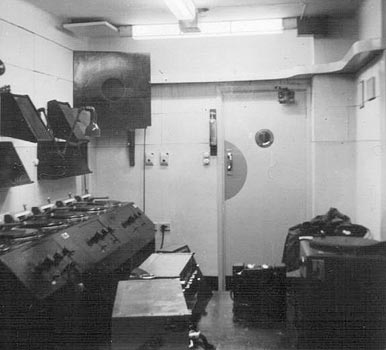
Mixer 3 Cubicle
This photo of the cubicle of Mixer 3 shows the TD/7 gram players. To the right is a Presto capable of playing 17" direct recordings or 16" pressings at 33-1/3 r.p.m.
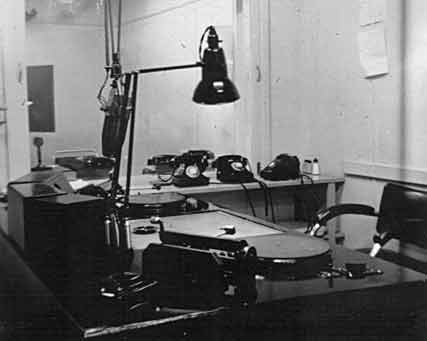
Green Continuity
- GREEN (General Overseas Service, right)
- RED (Arabic, Hebrew etc.)
- BROWN (Urdu, Hindi, Bengali etc.)
- PURPLE (North American Service )
In 1951 PEs and RPAs departments were amalgamated and a new department called Overseas Programme Operations was set up and operational staff were redesignated STUDIO MANAGERS! Similar departments were set up at Broadcasting House (Central Programme Operations) and Bush House (External Programme Operations). A new shift system was devised - two lates, two days, one night and three days off - the "three days off" looked good until you realised that you worked something like eight hours before the "off" bit started! There was no night shift pay and no extras of any sort for lost meal breaks, week-end working or anything else.
The new SMs OFFICE was on the ground floor overlooking Oxford Street and next to the RP Library. 'Hobby' was still our boss up on the 4th floor where he was ably assisted by Les Thompson, who later became Head of External Programme Operations at Bush House.
OVERSEAS BOOKINGS was also on the 4th floor and working there as a Bookings Clerk was a young lady I had first met when we were both Technical Assistants (Grade 1) at the Washford Transmitting Station in 1944. As I mentioned in the piece on Washford we were married on 25th November 1950.
The CANTEEN was on the ground floor and very good it was too - even those people up the road at BH used to use it! The atmosphere at 200 was very pleasant and friendly and being an SM there was a very enjoyable experience.
When 200 closed in 1957 all Services were transferred to Bush House, Overseas Programme Operations ceased to exist, and the building became a shop........

